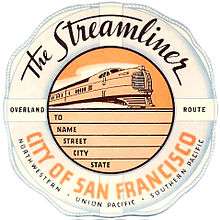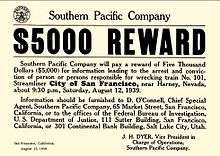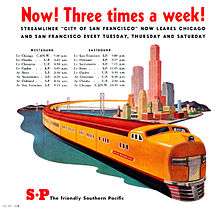City of San Francisco (train)
|
Union Pacific train 101, the City of San Francisco, near Cheyenne, Wyoming on December 4, 1948 |
The City of San Francisco was a streamlined through passenger train which ran from 1936 to 1971 on the Overland Route between Chicago, Illinois and Oakland, California, with a ferry connection on to San Francisco. It was owned and operated jointly by the Chicago and North Western Railway (1936–55), Chicago, Milwaukee, St. Paul and Pacific Railroad (1955-71), the Union Pacific Railroad, and the Southern Pacific Railroad. It provided premium extra fare service from Chicago to San Francisco when introduced in 1936 of 39 hr 45 min each way.
At 9:33 on the evening of August 12, 1939, the westbound City of San Francisco (TR 101) derailed while crossing bridge #4 in Nevada's Humboldt River canyon 40 miles west of Elko between the towns of Harney and Palisade killing 24 and injuring 121. The wreck appeared to have been caused by sabotage, but despite a major manhunt, offers of reward, and years of investigation by SP,[1] the case remains unsolved as to the perpetrators.[2]

Competing streamlined passenger trains were, starting in 1949, the California Zephyr on the Western Pacific, Denver and Rio Grande Western, and Chicago, Burlington and Quincy Railroads, and starting in 1954, the San Francisco Chief on the Atchison, Topeka and Santa Fe Railway. As with the City of Los Angeles, many of the train's cars bore the names of locales around its namesake city, including Mission Dolores, the nickname given to San Francisco's Mission San Francisco de Asís.
The City of San Francisco is remembered for the blizzard in the Sierra Nevada that trapped the train for six days in January 1952 at 39°19′34″N 120°35′35″W / 39.3262°N 120.593°W 17 miles (27 km) west of Donner Pass at Yuba Pass on Track #1 adjacent to Tunnel 35 (on Track #2), at about MP 176.5. Snowdrifts from 100 mph (160 km/h) winds blocked the train burying it in 12 feet of snow and stranding it from January 13 to 19. The event made international headlines. In the effort to reach the train, the railroad's snow-clearing equipment and snow-blowing rotary plows became frozen to the tracks near Emigrant Gap. Hundreds of workers and volunteers, including Georg Gärtner, using snowplows, tractors and manpower came to the rescue by clearing nearby Highway 40 to reach the train. The 196 passengers and 20 crewmembers were evacuated within 72 hours, on foot to vehicles that carried them the few highway miles to Nyack Lodge. The train itself was extricated three days later on January 19.[3]
In October 1955 the Milwaukee Road replaced the Chicago and North Western between Chicago and Omaha; in 1960 the City of San Francisco was combined with the City of Los Angeles east of Ogden. A May 1969 timetable is available online.[4]
Timeline and equipment consists






- June 14, 1936: The City of San Francisco (TR 101-102) made its inaugural run between Chicago and Oakland/San Francisco as streamline through service. It operated with a dedicated Pullman-built 11-car articulated lightweight streamline consist made up of a set of two 1,200 h.p. diesel-electric power unit cars (M-10004A/B), a baggage-mail car, a baggage-dormatory-kitchen car, a diner-lounge car, four named sleeper cars, a 48-seat chair car, and a 38-seat coach-buffet-blind end observation car.[5][6][7][8][9][10]
- January 2, 1938: The City's original train set was replaced with an all new quarter-mile (1,292-foot) long, semi-articulated 17-car lightweight streamline consist made up of one EMC-E2A and two EMC-E2B 1,800 h.p. diesel-electric power unit cars (SF 1-2-3) built by the Electro-Motive Corporation (now EMD), and 14 aluminum-alloy girder-type Pullman-built cars consisting of an auxiliary power-baggage-dormitory car, a 54-seat chair car, a 32-seat coffee shop-kitchen car, a 72-seat diner, a dormitory-buffet-lounge car, eight named sleeper cars, and an 84-foot 6-inch buffet-lounge-observation car (NOB HILL) said to be the "longest passenger car built in the United States" to that time.[11][12][13]
- While costing over $2,000,000 to build, operating costs (fuel, crew, etc) for the train were less than two cents per passenger-mile.[14] The extra fare on the City over the full run was $15 for open section Pullman accommodations, $5 in the chair car, and $22.50 for a roomette.[15] After both the original and new train sets made a joint run from Oakland to Chicago on that date, the older 11-car consist was shopped for a seven-month rebuild and then used variously over the next decade as the City of Los Angeles, City of Denver, and City of Portland before being withdrawn from service in the spring of 1948 and eventually scrapped.[16][17]
- The new and subsequent City of San Francisco train sets were jointly owned by the C&NW, UP and SP with the exception of the sleepers which were Pullman-owned until 1945 when two of those cars were acquired by the C&NW and a dozen by the UP.[18][19][20] The new train was capable of speeds up to 110 miles an hour and accommodated 222 passengers.[21] Sleeping car space was double that of conventional trains with 168 berths compared to 84 while chair car space was increased to 54.[22] The new City consist had 60 compartments, drawing rooms, bedrooms, and "roomettes" instead of the regular nine for a larger variety of sleeping accommodations to choose from than on any train in America.[23] Among the premium services provided on the train were stewardess-nurses, a barber shop, a shower bath, and an internal telephone system. All regularly assigned cars were also air-conditioned.[24] Frequency remained at five trips per month each way.
- August 12, 1939: The westbound City of San Francisco derailed while crossing the #4 bridge in the Humboldt River Gorge in northern Nevada. Two dozen passengers and crew members were killed with many more injured.[25] Five cars were destroyed and written off: SF 601 PRESIDIO (32-seat coffee shop-kitchen car), SF-602 MISSION DELORES (72-seat diner), SF-701 EMBARCADERO (dormitory-buffet-lounge car), and two sleepers, TWIN PEAKS and CHINATOWN.[26]
- July 26, 1941: A second set of equipment entered service allowing departures ten times per month each way. The added service replaced the short-lived steam powered Pullman-built mostly heavyweight (steel) streamline Forty-Niner that had operated an almost ten-hour slower 49-hour run five times a month between Chicago and San Francisco from July 8, 1937 to July 27, 1941.[27][28] Under an order of the War Production Board, no new head-end or passenger cars of any type (other than "military sleepers") were built and delivered to US railroads from mid 1942 until late 1945.[29]
- 1942-46: The lounge-observation car NOB HILL and lounge-buffet car MARINA were removed from the consists of the City of San Francisco's two train sets and placed in storage during WWII in compliance with a General Order of the Office of Defense Transportation (ODT) banning the carriage of strictly luxury cars without passenger revenue capacity. Those cars were replaced with sleepers.[30][31][32]
- October 1, 1946: Service was increased to thrice weekly departures from both Chicago and San Francisco made every Tuesday, Thursday and Saturday evening.[33]
- September 1, 1947: The City became daily with the creation of additional train sets to support seven-day-a-week operation in both directions of its 39-and-a-half-hour service thus finally relegating the long-standing (since 1887) Overland to a secondary, no longer "Limited" train in providing daily service between Chicago and Oakland/San Francisco on the Overland Route.[N 1][34][35] A fifth consist made possible by the deliveries of new post war cars was added to the City of San Francisco in 1950.[36]
- January 13, 1952: The westbound City of San Francisco was caught in a blizzard in the Sierras at Yuba Pass where the train set remained stranded until January 19. The incident was one inspiration for Railway series book, The Twin Engines.
- October 30, 1955: The Chicago, Milwaukee, St. Paul and Pacific Railroad (The Milwaukee Road) replaced the Chicago and North Western between Chicago and Omaha.[37]
- July 16, 1962: The SP's San Francisco Overland (TR 27-28) ended its long run as a separate San Francisco/Oakland to Ogden year-round daily train when that service was consolidated with the City of San Francisco except for occasional summer and holiday seasonal extra section runs of the Overland which service ended on January 2, 1964.[38][39]
- May 1, 1971: Operation of the City of San Francisco was discontinued by the MILW-UP-SP when Amtrak took over all long-distance inter city passenger operations in the United States although Amtrak retained the name for the thrice-weekly Denver-San Francisco/Oakland portion of the run until June, 1972 when the entire Chicago-San Francisco/Oakland route became daily again as the San Francisco Zephyr.[40] Amtrak replaced its service between Chicago and San Francisco/Oakland on July 16, 1983 with its current daily train, the California Zephyr, when a portion of the route was moved from UP tracks in Wyoming to those of the Denver Rio Grande Western in Colorado.[41]
Consist listings (1936-1968)
_consists_1936.jpg)
_consists_1941.jpg)
_consists_1948.jpg)

_consists_1968.jpg)
Route diagram
_Route_Diagram_1936.jpg)
Other railroad uses of the name City of San Francisco
The City of San Francisco name has been applied to a 10/6 sleeping car built by Pullman Standard in the early 1950s. The car is now owned by the Boone and Scenic Valley Railroad and operates on the line's dinner and first class trains. Union Pacific itself has a dome lounge car used on excursion and executive trains which carries the "City of San Francisco" name.
See also
- Passenger train service on the Chicago and North Western Railway
- Passenger train service on the Milwaukee Road
- Passenger train service on the Southern Pacific Railroad
- Passenger train service on the Union Pacific Railroad
References
- DeNevi, Don. (1979). Tragic Train: The City of San Francisco -- The Development and Historic Wreck of a Streamliner., Superior Publishing. ISBN 0875645259.
- Dubin, Arthur D. (1964) Some Classic Trains. Milwaukee: Kalmbach Books.
- Haine, Col. Edgar A. (1994). Train Wrecks. Cranbury, NJ: Cornwall Books
- Heath, Erle (1945). Seventy-Five Years of Progress: Historical Sketch of the Southern Pacific. San Francisco: Southern Pacific Railroad.
- Schafer, Mike; Welsh, Joe (1997). Classic American Streamliners. Osceola, WI: MotorBooks International. ISBN 0-7603-0377-0. OCLC 37281634.
- Solomon, Brian (2000). Union Pacific Railroad. Osceola, WI: MBI. ISBN 0-7603-0756-3. OCLC 44406086.
- Strack, Don (1999). Diesels of the Union Pacific, 1934-1982, The Classic Era, Volume 1 Halifax, Pa.: Withers Publishing Co.
- Wayner, Robert J. (1972). Car Names, Numbers and Consists. New York: Wayner Publications
Notes
- ↑ According to Robert Wayner in Car Names, Numbers, and Consists (1972) at page 158: "The first new postwar lightweight cars for Overland Route service were not delivered until 1949. However, the participating railroads were obliged to place the CITY OF PORTLAND, CITY OF LOS ANGELES and CITY OF SAN FRANCISCO in daily operation in February, May and September of 1947 respectively to meet the competition of such trains as the GOLDEN STATE and the OLYMPIAN HIAWATHA. The creation of eight additional consists meant the commandeering of a great number of lightweight cars from the CHALLENGER, SAN FRANCISCO OVERLAND LIMITED and other trains, plus the requisitioning of a few heavyweight cars where needed. All such equipment was then painted yellow-and-gray and in some instances lettered above window level for the train in which a given car would be running. The luxury of an extra set of cars to permit a leisurely turnaround at the end of the run was out of the question; daily service was established and maintained between Chicago and each Pacific Coast terminal with only four consists, permitting but a half-day at each end for all necessary cleaning, provisioning and maintenance. If bad weather in the high Sierra delayed the CITY OF SAN FRANCISCO'S arrival in Oakland or Chicago by more than a few hours, a mostly-heavyweight train had to be hastily assembled and dispatched that evening as the CITY OF SAN FRANCISCO starting in the opposite direction."
Footnotes
- ↑ DeNevi, Don. "Tragic Train: The City of San Francisco -- The Development and Historic Wreck of a Streamliner." (1979) Superior Publishing. ISBN 0875645259.
- ↑ http://www2.gbcnv.edu/howh/CitySF.html
- ↑ Bull, Howard W. The Case of the Stranded Streamliner" The rescue of SP's snowbound "City of San Francisco"at Yuba Pass, January 13-19, 1952. Trains & Travel (magazine), Vol 13, #3, January, 1953. CPRR.org
- ↑ http://www.streamlinerschedules.com/concourse/track8/citysanfran196906.html
- ↑ Wayner, Robert J. "Car Names, Numbers and Consists". New York: Wayner Publications (1972) p. 142
- ↑ M-10004 CITY OF SAN FRANCISCO The Coach Yard.com
- ↑ Schafer, Mike; Joe Welsh (1997). Classic American Streamliners. Osceola, WI: MotorBooks International p. 17
- ↑ Heath, Erle Seventy-Five Years of Progress: Historical Sketch of the Southern Pacific (1945) San Francisco: Southern Pacific Railroad. pp.38-39
- ↑ Strack, Don "Diesels of the Union Pacific, 1934-1982, The Classic Era, Volume 1" Halifax, Pa.: Withers Publishing Co. (1999)
- ↑ A railroad train "consist" is defined by 49 CFR §210.7 as "one or more locomotives coupled to a rail car or rail cars." Office of the Federal Register, National Archives and Records Administration. Code of Federal Regulations, Title 49, Parts 200 to 299, Transportation. Washington, D.C.: U.S. Government Printing Office (2005), p. 59
- ↑ DeNevi 1977 pp. 9-13
- ↑ Wayner 1972 p. 139, 150
- ↑ "Southern Pacific Passenger Trains: The City of San Francisco" Espee.Railfan.net
- ↑ DeNevi 1977 p. 15
- ↑ DeNevi 1977 p. 15
- ↑ Heath 1945 p. 39
- ↑ Wayner 1972 pp. 142-44
- ↑ The Official Guide of the Railways and Steam Navigation Lines of the United States, Puerto Rico, Canada, Mexico and Cuba, Volume 70, Issue 8 (1938). New York: National Railway Publication Company, p. 39
- ↑ "Railway Age" Vol. 111 (1941). New York: Simmons-Boardman Publishing Corporation. p. 305
- ↑ Wayner 1972 p. 152-53
- ↑ "NEW STREAMLINER FOR S.F.-CHICAGO RUN". San Francisco: Southern Pacific News Bureau. January 17, 1938
- ↑ DeNevi 1977 p. 15
- ↑ DeNevi 1977 p. 15
- ↑ Dubin, Arthur D. (1964) Some Classic Trains. Milwaukee: Kalmbach Books. pp. 186-189
- ↑ Haine, Col. Edgar A. "Train Wrecks". Cranbury, NJ: Cornwall Books (1994) p. 107
- ↑ Wayner 1972 p. 150
- ↑ Heath 1945 p. 39
- ↑ Wayner 1972 p. 150
- ↑ "RAILROADS: The U.P. Trail" (cover story). TIME (Magazine), July 30, 1945
- ↑ Wayner 1972 p. 157
- ↑ President Franklin D. Roosevelt: "Executive Order 8989 Establishing the Office of Defense Transportation", December 18, 1941 The American Presidency Project, University of California, Santa Barbara
- ↑ Eastman, Joseph B. "The Office of Defense Transportation" Annals of the American Academy of Political and Social Science, Vol. 230, Transportation: War and Postwar (Nov., 1943), pp. 1-4
- ↑ 1942 Annual Report, The Chicago & Northwestern Railway Company, p. 7
- ↑ Beebe, Lucius Morris The Overland Limited. Berkeley, CA: Howell-North Books (1963) p. 50.
- ↑ Heath 1945 p. 39
- ↑ Wayner 1972 p. 163
- ↑ "Now ... Service to all the West". The Milwaukee Road Magazine, Vol. 43, No. 7. October, 1955. pp. 4-6
- ↑ ICC Financial Docket No. 21946 (Filed February 5, 1962, decided July 6, 1962, served July 16, 1962)
- ↑ Southern Pacific Overland Route Time Tables (Form 4), July 16, 1962
- ↑ "San Francisco Zephyr route guide, 1975." Amtrak A History of America's Railroad. http://history.amtrak.com
- ↑ "Last passenger trains rolling across Wyoming". Spokesman-Review. July 13, 1983.
External links
| Wikimedia Commons has media related to City of San Francisco. |
- "The Case of the Stranded Streamliner" offers detailed information and photographs of the 1952 disaster.
- "Recalling a Train Wreck" offers information and photographs of the 1939 derailment.
